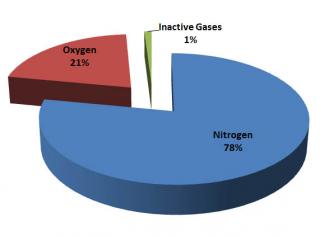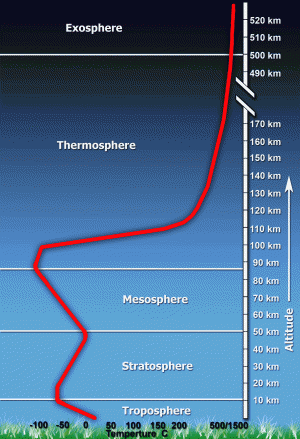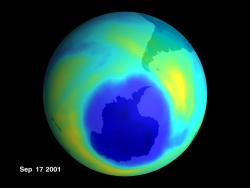Earth’s Atmosphere
Which Gases Make Up Earth’s Atmosphere?
Earth’s relatively thin atmosphere primarily consists of a mixture of nitrogen (78%) and oxygen (21%) gases. The remaining 1% contains several inactive gases (i.e., argon, neon, helium, hydrogen, and xenon) and several other gases that vary in concentration (i.e., water vapor, carbon dioxide, methane, nitrous oxide, ozone, and chlorofluorocarbons). Although water vapor and carbon dioxide make up a very small amount of the gases in Earth’s atmosphere, they are very important because of their ability to absorb heat. Throughout the upcoming modules, you will learn much more about why and how the concentrations of water vapor and carbon dioxide vary.
How is Earth's Atmosphere Structured?
Earth’s atmosphere is relatively thin, extending up to at least 500 kilometers (300 miles) above the planet’s surface. The atmosphere is structured in different layers according mainly to variations in temperature.
Troposphere
The lowest layer is known as the troposphere, which makes up approximately 75% of the total mass of the atmosphere and contains 99% of the atmosphere’s water. The troposphere extends up to approximately 11 kilometers (7 miles) from the surface and is the layer where atmospheric gases are most concentrated. Nearly all weather happens in the troposphere, and the jet stream — a narrow, fast-moving “river” of wind — flows at the upper edge of this layer of the atmosphere.
Air temperature in the troposphere typically decreases as altitude increases as a result of three mechanisms of heat transfer (radiation, conduction, and convection). You will learn more about these heat transfer mechanisms in the next section on Earth’s energy balance, but here is a brief overview.
Solar radiation passes through Earth’s atmosphere and heats up the planet’s surface. The oceans and land absorb approximately half of this incoming solar radiation while a small fraction is emitted back into the atmosphere as infrared radiation. The heat absorbed by Earth’s surface is then transferred directly from the land (or the water) to the cooler air closest to the surface through conduction (the direct spread of heat from one substance to another). Once heated, this air becomes less dense (or lighter) and rises through a process called convection. As the air rises, it expands and discharges its heat as it flows upward through the troposphere. After the heat is discharged and the air cools, it becomes denser and begins to sink. Consequently, the troposphere is generally warmest near Earth’s surface and coolest at its highest point.
Stratosphere
The next layer, known as the stratosphere, extends from the troposphere upward to approximately 50 kilometers (31 miles) above Earth’s surface. In the stratosphere, air temperature begins to increase.
Ozone, a form of oxygen with three atoms per molecule, is concentrated in the stratosphere. Ozone absorbs most of the ultraviolet (UV) radiation coming from the sun, preventing this radiation from reaching Earth’s surface. UV radiation is harmful to living things because it damages and destroys cells.
The absorption of UV radiation in this ozone layer causes temperature to increase, creating what is known as a temperature inversion — where air temperature increases with height rather than decreases, as it does in the troposphere.
The Ozone Hole
About 30 years ago, scientists discovered that the ozone layer was breaking down, so much that a large hole formed over Antarctica. Chlorofluorocarbons (CFCs) were discovered to be the cause of the decrease in ozone. Man-made CFCs are used as coolants in air conditioners and refrigerators and in aerosol spray cans. Most countries have stopped using the most harmful CFCs, and the concentration of ozone in the upper atmosphere is now increasing.
Mesosphere
Above the stratosphere, lies the mesosphere, which stretches to approximately 90 kilometers (56 miles) above the surface of Earth. In the mesosphere, temperature begins to decrease again. The mesosphere’s lower temperature results, in part, from the low concentration of ozone, so little solar radiation is absorbed in this layer. The mesosphere is dark, with air pressure so low that a human could not survive in this layer.
Thermosphere
The thermosphere lies above the mesosphere and extends approximately 600 kilometers (373 miles) beyond Earth’s surface. Temperature begins to increase again in the thermosphere. The increase in temperature, or inversion, is due in part to the absorption of UV and x-ray radiation and the impact of the solar wind — a continuous stream of protons and electrons given off by the sun. Low Earth orbit (LEO) satellites — like the International Space Station — circle our planet in the thermosphere.
Exosphere
The exosphere represents the outermost layer of Earth’s atmosphere. It extends from the top of the thermosphere to 10,000 kilometers (6,214 miles) above Earth’s surface. In this layer, atoms and molecules escape into space, and higher altitude satellites orbit our planet.
In the next section, we will discuss the effects of radiation in more detail as well as the role this energy plays in maintaining Earth’s climate.



